Intercity (Deutsche Bahn)
This article needs additional citations for verification. (May 2012) |
 | |
 DB Intercity to Dresden in 2016 | |
| Overview | |
|---|---|
| Locale | Germany |
| Dates of operation | 1971–present |
| Predecessor | F-Zug |
| Technical | |
| Track gauge | 1,435 mm (4 ft 8+1⁄2 in) standard gauge |
| Other | |
| Website | bahn.com |
Intercity, often shortened to IC, is the second-highest train classification in Germany, after the Intercity Express (ICE). Intercity services are locomotive-hauled express trains, usually over long-distances. There are Intercity routes throughout Germany and routes generally operate every other hour, with multiple routes giving a more frequent service on core routes. Intercity services are operated by the DB Fernverkehr division of Deutsche Bahn, Germany’s national railway.
The Intercity name was introduced in Germany in 1971, replacing the F-Zug category, and was the top category of train in Germany until the introduction of the high-speed ICE services in the early 1990s. With the proliferation of ICE services, the role of IC trains has diminished slightly. Nonetheless, Intercity trains still offer a high standard of average speed and comfort – all routes offer first class coaches, and most include some sort of catering - however all Buffet cars and restaurant cars have been retired in 2023. Several IC services are composed of older coaches while being gradually replaced with newer Intercity 2 trainset rolling stock with some lines also being upgraded to ICE services and trainsets.
A number of German Intercity services serve destinations outside Germany, usually to Austria and the Netherlands with some operating under the EuroCity brand.
History
[edit]Inception
[edit]
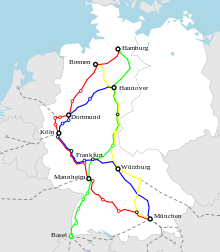

The idea for Intercity services on the Deutsche Bundesbahn network was first proposed in 1967, inspired by the success of British Rail's InterCity brand. After some planning, the proposal was approved in 1969, and the services were finally introduced in September 1971, after some delays in delivery of new coaching stock. The original network consisted of four lines, operating every two hours, and connecting the largest cities in West Germany. At this time, Intercity trains were first-class only. The original lines were:
- line 1 (red): Hamburg-Altona – Bremen – Münster (Westf) – Dortmund – Essen – Duisburg – Düsseldorf – Cologne – Bonn – Koblenz – Mainz – Mannheim – Heidelberg – Stuttgart – Ulm – Augsburg – Munich
- line 2 (blue): Hannover – Bielefeld – Hamm – Dortmund – Hagen – Wuppertal-Elberfeld (– Solingen-Ohligs) – Cologne – Bonn – Koblenz – Wiesbaden – Frankfurt (Main) – Würzburg – Nuremberg – Augsburg – Munich
- line 3 (green): Hamburg-Altona – Hannover – Göttingen – Fulda – Frankfurt (Main) – Mannheim – Karlsruhe – Freiburg (Breisgau) – Basel
- line 4 (gold): Bremen – Hannover – Göttingen – Bebra – Fulda – Würzburg (– Ingolstadt) – Munich
Gradually, the Intercity network started to expand, and with the introduction of the Class 103 locomotives, 200 km/h running was possible. Services were increased in frequency to hourly, and second class accommodation was provided – in 1979 this was promoted with the slogan "every hour, every class".
Additionally, there is also another new line 5, running from Dortmund to Munich. It was opened since 2 May 1985.
- line 1 (red): Hamburg-Altona – Bremen – Osnabrück – Münster (Westf) – Dortmund – Bochum – Essen – Duisburg – Düsseldorf – Köln – Bonn – Koblenz – Wiesbaden – Frankfurt (Main)
- line 2 (brown): Hannover – Bielefeld – Hamm – Dortmund – Essen – Duisburg – Düsseldorf – Cologne – Bonn – Koblenz – Mainz – Mannheim – Heidelberg – Stuttgart – Ulm – Augsburg – Munich
- line 3 (green): Hamburg-Altona – Hannover – Göttingen – Fulda – Frankfurt (Main) – Mannheim – Karlsruhe – Freiburg (Breisgau) – Basel (– Switzerland)
- line 4 (gold): Hamburg-Altona – Hannover – Göttingen – Bebra – Fulda – Würzburg – Augsburg – München
- line 4a (grey): Oldenburg or Bremerhaven – Bremen – Hannover
- line 5 (blue): Dortmund – Hagen – Wuppertal-Elberfeld (– Solingen-Ohligs) – Cologne – Bonn – Koblenz – Mainz – Frankfurt Airport – Frankfurt (Main) (– Aschaffenburg) – Würzburg – Nuremberg – Augsburg – Munich
The InterCity for 3a is also part of the TransEuropExpress:
- line 3a: Amsterdam – Utrecht – Oberhausen – Duisburg – Düsseldorf – Köln – Bonn – Koblenz – Mainz – (Mannheim – Karlsruhe – Freiburg (Breisgau) – Basel) or (Mannheim – Heidelberg – Stuttgart – Ulm – Augsburg – Munich – Salzburg) or (Frankfurt Airport – Frankfurt (Main) – Würzburg – Augsburg – Munich – Innsbruck)
Some ICs switched between lines 4 and 5, 2 and 5 (Essen or Wuppertal), or 2 and 3 (Basel or Stuttgart).
Reunification and growth
[edit]


The network continued to evolve throughout the 1980s, and in the early 1990s it saw major changes. One major driving force for this was German reunification, which saw the network expand across the former East Germany, but also the opening of two high-speed lines in 1991: Mannheim to Stuttgart and Hannover to Würzburg. The first generation ICEs were introduced around this time, and took over most services on the Hannover – Fulda corridor, while the remaining services expanded in all directions.
The routes on 2 June 1991 were as follows:
- IC line 1 (red): Hamburg-Altona – Bremen – Münster (Westf) – Dortmund – Essen – Duisburg – Düsseldorf – Cologne – Bonn – Koblenz – Mainz – Frankfurt (Main) Flughafen – Frankfurt (Main) – Aschaffenburg – Würzburg – Nürnberg – (Ingolstadt – Munich) or (Regensburg – Passau – Linz – Wien) (connecting to Austria)
- IC line 1a (magenta): Wiesbaden – Frankfurt (Main) (every two hours)
- IC line 2 (brown): (Dortmund – Bochum) or (Münster (Westf) – Recklinghausen – Gelsenkirchen) – Essen – Duisburg – Düsseldorf – Köln – Bonn – Koblenz – Mainz – Mannheim – Heidelberg – Stuttgart – Ulm – Augsburg – Munich (eight EC train pairs via Salzburg to Budapest, Klagenfurt, Wien or Zagreb)
- IC line 2a (magenta): Wiesbaden – Mainz
- IC line 3 (green): Berlin – Potsdam – Magdeburg – Helmstedt – Braunschweig – Hildesheim – Göttingen – Kassel-Wilhelmshöhe – Fulda – Frankfurt (Main) – Mannheim – Karlsruhe (every two hours, one EC train pair via Basel to Zürich)
- IC line 4 (gold): Hamburg-Altona – Hannover – Göttingen – Kassel-Wilhelmshöhe – Fulda – Würzburg – Augsburg – Munich (every two hours to Nuremberg)
- IC line 5 (blue): (every two hours: Berlin – Potsdam – Magdeburg –) Braunschweig – Hannover– Bielefeld – Hamm – Dortmund – Hagen – Wuppertal – Solingen-Ohligs – Cologne – Bonn – Koblenz – Mainz – Mannheim – Karlsruhe – Freiburg (Breisgau) – Basel (new EC pairs of trains to Brig, Chur, Geneva, Interlaken, Milan or Sestri Levante)
- EC line 5a (lilac): Amsterdam – Utrecht – Emmerich – Oberhausen – Duisburg – Düsseldorf – Cologne (every two hours, two EC train pairs on line 5 to Chur and Interlaken)
- ICE line 6 (orange): Hamburg-Altona – Hannover – Göttingen – Kassel-Wilhelmshöhe – Fulda – Frankfurt (Main) – Mannheim – Stuttgart – Ulm – Augsburg – Munich
- IC line 6a (grey): Oldenburg or Bremerhaven – Bremen – Hannover
Meanwhile, a new type of express train – the InterRegio – was created in the late-1980s, replacing the old D-Zug services, providing semi-fast services to complement Intercity trains.
The new changes on 31 May 1992 were as follows:
- IC line 1 (red): from Nuremberg to Munich
- IC line 3 (green): Hamburg-Altona – Hannover – Göttingen – Kassel-Wilhelmshöhe – Fulda – Frankfurt – Mannheim – Karlsruhe (– Basel – Zürich)
- ICE line 4 (yellow): either Bremen or Hamburg-Altona, to Nuremberg
- IC line 6a (grey): every two hours Bremen – Hannover
- IC line 8 (lime): Berlin – Flughafen Berlin-Schönefeld – Leipzig – Naumburg – Jena – Saalfeld – Probstzella – Lichtenfels – Bamberg – Erlangen – Nuremberg – Ingolstadt – Munich (every two hours)
From 1996, IC line 8 was connected from Berlin to Hamburg, which together with IC line 7 between the two cities, which ran until 1998, created an hourly service. IC line 5 ran from 1997 via Hanover Magdeburg and Leipzig to Dresden instead of Berlin. as a result, the new ICE line 10 was established from Berlin to Cologne/Bonn. At the same time, the branch to Basel, which was previously served by IC line 5, was abandoned. The line now ended in Nuremberg. From 1998 the trains of ICE line 6 and ICE line 10 ran over the new Berlin–Hanover line.
Modern era
[edit]The next major change to Intercity services came about in 2002, with the opening of the Cologne–Frankfurt high-speed rail line largely to replace the West Rhine Railway, a major trunk route for Intercity services. While previous high speed lines in Germany had been designed for mixed usage, and could be used by Intercity trains, this line can only be operated by new ICE 3 units. This, along with the introduction of another generation of ICEs, the ICE T, saw large numbers of Intercity routes converted to ICE. Meanwhile, the InterRegio classification was abolished, and many of its services converted into Intercity routes.
As a result, the character of Intercity has changed. Having been on an almost equal footing with the ICE, it is very much secondary. While it still provides a high quality of service, trains now stop more frequently, and are more commonly found on lesser routes. Most current IC trains convey fewer first-class coaches, more open seating as opposed to compartments, and a Bistro Cafe (buffet car) instead of a restaurant or no on-board catering at all, although this is as much a reflection of the changing habits of modern passengers than it is a change in the status of Intercity trains. Until 2023, Lines 30 and 31 – Hamburg to Frankfurt/Stuttgart were closest in character to a 'classic' Intercity train, but these have now been abolished, with sections of these services reallocated to lines such as 43 and 55.
Current services
[edit]Deutsche Bahn's long distance services are operated over numbered routes. If they are operated by Intercity-Express rolling stock they are considered to be Intercity-Express lines. Lines operated by Intercity rolling stock or a mixture of Intercity and Intercity-Express sets are listed below (as of 2022).
Line 17
[edit]IC line 17 was established on 15 December 2019. This is a service that has been served every two hours since 9 March 2020. Between Rostock and Berlin, IC line 17 is the successor to Interregio line 14, which operated here until 2002. Some services of trains on IC line 28 are replaced here by line 17. On the section between Berlin and Dresden, the line supplements the heavily used Eurocity line 27 to Prague and has connected Berlin Brandenburg Airport (BER) since it opened.
Since the Stadler KISS multiple units used on IC route 17 are owned by the Austrian WESTbahn and are serviced in Vienna, a pair of trains runs six times a week overnight between Rostock and Vienna via Nuremberg.
| Line | Route | |
|---|---|---|
| IC 17 | (Warnemünde –) Rostock – Waren – Neustrelitz – Oranienburg – Berlin-Gesundbrunnen – Berlin – Berlin Südkreuz – | |
| Berlin Brandenburg Airport – Doberlug-Kirchhain – Elsterwerda – Dresden-Neustadt – Dresden (– Freiberg – Chemnitz) | ||
| Lutherstadt Wittenberg – Bitterfeld – Leipzig – Halle (S) – Naumburg – Jena Paradies – Jena-Göschwitz – Saalfeld – Lichtenfels – Bamberg – Erlangen – Fürth – Nuremberg – Regensburg – Straubing – Plattling – Passau – Schärding – Wels – Linz – St. Pölten – Vienna Meidling – Vienna | ||
Line 24
[edit]Intercity rolling stock is used for one train pair on ICE/IC line 24. It runs from Hamburg via Hanover, Kassel and Würzburg to Augsburg where the train splits, with one portion continuing to Munich and Berchtesgaden and the other continuing to Oberstdorf.
| Line | Route | |
|---|---|---|
| IC 24 | Hamburg-Altona – Hamburg Dammtor – Hamburg – Hamburg-Harburg – Lüneburg – Uelzen – Celle – Hanover – Göttingen – Kassel – Fulda – Würzburg – Steinach (b Rothenburg ob der Tauber) – Ansbach – Treuchtlingen – Donauwörth – Augsburg – | Munich-Pasing – Munich East – Rosenheim – Bad Endorf – Prien am Chiemsee – Übersee – Traunstein – Freilassing – Bad Reichenhall – Bad Reichenhall-Kirchberg – Bayerisch Gmain – Bischofswiesen – Berchtesgaden |
| Buchloe – Kaufbeuren – Kempten – Immenstadt – Sonthofen – Fischen – Oberstdorf | ||
Line 26
[edit]Intercity rolling stock are used for some rotations on ICE/IC line 26.
Line 27
[edit]On the main route of EC line 27, Intercity and Eurocity services run every two hours between Hamburg and Prague. A pair of trains continue to Budapest. One pair of trains a day runs between Westerland or Dagebüll and Berlin. Between Berlin and Dresden, together with line 17, there is a service approximately every hour. Since 16 June 2020, a pair of Railjet services have operated as ICE 27 between Berlin and Graz.
| Line | Route | |||
|---|---|---|---|---|
| EC 27 | Hamburg-Altona – | Hamburg Dammtor – Hamburg – Hamburg-Bergedorf – Büchen – Ludwigslust – Wittenberge – Berlin-Spandau – Berlin – Berlin Südkreuz – Elsterwerda – Dresden-Neustadt – Dresden – Bad Schandau – Děčín – Ústí nad Labem – Praha-Holešovice – Prague (– Pardubice – Česká Třebová – Brno – Břeclav – Kúty – Bratislava – Nové Zámky – Štúrovo – Szob – Nagymaros-Visegrád – Vác – Budapest Keleti) | ||
| Kiel – Neumünster – | ||||
| Westerland – Niebüll1 – Husum – Heide – Itzehoe – | ||||
| Flensburg – Schleswig – Rendsburg – Neumünster – | ||||
1 Norddeutsche Eisenbahngesellschaft Niebüll runs through coaches from Niebüll to Dagebüll Mole via the following stations. They do not run as IC services, but as NEG regional services:
| Route |
|---|
| – Niebüll – Deezbüll – Maasbüll – Dagebüll Kirche – Dagebüll Mole |
Line 28
[edit]Only a few trains run on line 28, which connects Nuremberg with Munich via Augsburg.
| Line | Route |
|---|---|
| IC 28 | Nuremberg – Treuchtlingen – Donauwörth – Augsburg – Munich |
Line 29
[edit]Since the 2024 annual timetable, the IC has been running between Westerland, Dagebüll and Berlin as part of line 29. Keitum and Klanxbüll are only served by the southbound train, while Dagebüll Kirche, Maasbüll and Deezbüll are only served by the northbound train.
| Line | Route | Stock | |
|---|---|---|---|
| IC 29 | Westerland (→ Keitum → Klanxbüll) – | Niebüll – Husum – Heide – Itzehoe – Hamburg Dammtor – Hamburg – Ludwigslust – Berlin-Spandau – Berlin – Berlin Südkreuz | class 218 / class 101 + IC 1 coaches |
| Dagebüll Mole – (Dagebüll Kirche ← Maasbüll ← Deezbüll ←) Niebüll neg – |
Line 32
[edit]Since the start of the 2024 annual timetable, the line only consists of IC 2012/2013 train pair (Allgäu).
| Line | Route | ||
|---|---|---|---|
| IC 32 | Dortmund – Bochum – Essen – Mülheim – Duisburg – Düsseldorf – Cologne – Bonn – Remagen – Andernach – Koblenz – Bingen – Mainz – Mannheim – Heidelberg – Stuttgart – Plochingen – Göppingen – Ulm – Memmingen – Kempten – Immenstadt – Sonthofen – Fischen – Oberstdorf | ||
ICE train pair ICE 32 118/119 (Bodensee) also runs on the line.
Line 34
[edit]Trains run every two hours between Frankfurt and Siegen. Two pairs of trains run at high speed from Siegen via Unna and Hamm to Münster and continue via Emden to Norddeich Mole; the other six train pairs take over almost all stops for regional traffic and run to Dortmund or via Dortmund to Münster. These slower trains can also be used between Dillenburg and Iserlohn-Letmathe with local tickets. The first train on Mondays to Fridays towards Dortmund runs from Stuttgart via Karlsruhe, Heidelberg, Mannheim and Frankfurt Airport.
| Line | Route | |
|---|---|---|
| IC 34 | (Stuttgart – Ludwigsburg – Pforzheim – Karlsruhe – Bruchsal – Wiesloch-Walldorf – Heidelberg – Mannheim – Frankfurt Airport –) Frankfurt – Frankfurt West – Bad Nauheim – Wetzlar – Dillenburg – Siegen – | |
| Lennestadt-Altenhundem – Iserlohn-Letmathe – Schwerte – Unna – Hamm – Münster (– Rheine – Lingen – Meppen – Papenburg – Leer – Emden – Norden – Norddeich – Norddeich Mole) | ||
| Siegen-Weidenau – Kreuztal – Lennestadt-Altenhundem – Lennestadt-Grevenbrück – Finnentrop – Plettenberg – Werdohl – Altena – Iserlohn-Letmathe – Witten – Dortmund (– Hamm – Münster) | ||
Line 35
[edit]Trains run every two hours between Emden and Cologne. Some trains start at Norddeich Mole or Emden Außenhafen. South of Cologne, individual trains continue to Koblenz and on weekends to Konstanz or Stuttgart. Emden Außenhafen is only served from March to October. A pair of trains runs from Norddeich Mole to Bonn-Bad Godesberg and from Bad Godesberg to Emden. A pair of trains runs daily from Koblenz (on weekends from Cologne) to Bremerhaven-Lehe or from Bremerhaven-Lehe to Cologne. All IC trains running between Leer and Norddeich Mole can be used with local tickets. Since December 2023, some train pairs have been running as ICE 35.
| Line | Route | Stock | ||
|---|---|---|---|---|
| IC 35 | (Norddeich Mole – Norddeich – Norden) or (Emden Außenhafen –) Emden – Leer – Papenburg – Meppen – Lingen – Rheine – | Münster – Recklinghausen – Wanne-Eickel – Gelsenkirchen – Oberhausen – Duisburg – Düsseldorf Airport – Düsseldorf – Cologne – Bonn – Remagen – Andernach – Koblenz – Bingen – Mainz – Worms – Mannheim – | Karlsruhe – Baden-Baden – Offenburg – Hausach – Hornberg – Triberg – Sankt Georgen – Villingen – Donaueschingen – Immendingen – Singen – Radolfzell – Konstanz | IC2 |
| Bremerhaven-Lehe – Bremerhaven – Osterholz-Scharmbeck – Bremen – Osnabrück – | Stuttgart | |||
Line 37
[edit]Since the 2018 annual timetable, a daily pair of trains has again been running between Düsseldorf and Luxembourg. Until December 2014, this section was part of line 35. (Stadler KISS) double-deck multiple units of the CFL are used. On the Koblenz–Trier railway, the train runs as an RE, between Koblenz and Düsseldorf as an IC on behalf of DB Fernverkehr with the option of reserving seats and taking bicycles.[1]
| Line | Route |
|---|---|
| IC 37 | Düsseldorf – Cologne – Bonn – Remagen – Andernach – Koblenz – Kobern-Gondorf – Treis-Karden – Cochem – Bullay – Wittlich – Schweich – Trier – Wasserbillig – Luxemburg |
Line 50/51
[edit]Line 51 is based on ICE 50 and supplements it with relief journeys on Fridays and Sundays as well as journeys on the "Mid-Germany Railway" (Mitte-Deutschland-Verbindung, MDV). It was called line 50 between 2018 and December 2022. Line 51 MDV runs three pairs of trains between Düsseldorf/Cologne and Gera/Leipzig via Dortmund, Hamm, Soest, Lippstadt, Paderborn, Altenbeken, Warburg, Kassel-Wilhelmshöhe, Bebra, Eisenach, Gotha and Erfurt. The services that relieve the ICE line during peak hours are grouped as line 51 E. The "E" stands for Entlastungsverkehr (relief traffic).
| Line | Line part | Train pairs | Route | |
|---|---|---|---|---|
| IC 51 | 51 MDV | IC 2150/2151 IC 2152/2155 IC 2156/2157 |
Gera – Hermsdorf-Klosterlausnitz – Stadtroda – Jena-Göschwitz – Jena West – Weimar – Erfurt – Gotha – Eisenach – Kassel-Wilhelmshöhe – Warburg – Altenbeken – Paderborn – Lippstadt – Soest – Hamm – Dortmund – Bochum – Essen – Duisburg – Düsseldorf Airport – Düsseldorf ← Cologne | |
| 51 E | IC 1950/1951 IC 1956/1957 |
Berlin – Berlin Südkreuz – Lutherstadt Wittenberg – Bitterfeld – Halle (Saale) – Leipzig – Weimar – Erfurt – Gotha – Eisenach – Bad Hersfeld – Hünfeld – Fulda – Schlüchtern – Hanau – Offenbach – Frankfurt – Darmstadt – Bensheim – Weinheim – Heidelberg – Wiesloch-Walldorf – Karlsruhe-Durlach – Karlsruhe | ||
Line 55
[edit]Line 55 runs every two hours from Dresden via Leipzig, Magdeburg, Hanover, Dortmund, Hagen and Wuppertal to Cologne. With the annual timetable change in December 2022, the line was extended to Stuttgart as a replacement for line 30. Since December 2023, one train pair has continued to/from Tübingen, replacing a train pair on line 32.
| Line | Route | Stock |
|---|---|---|
| IC 55 | Dresden – Dresden-Neustadt – Riesa – Leipzig – Leipzig/Halle Airport – Halle – Köthen – Magdeburg – Helmstedt – Braunschweig – Hanover – Minden – Bad Oeynhausen – Herford – Bielefeld – Gütersloh – Hamm – Dortmund – Hagen – Wuppertal – Solingen – Cologne – Bonn – Koblenz – Mainz – Mannheim – Heidelberg – Vaihingen (Enz) – Stuttgart – Plochingen – Nürtingen – Metzingen – Reutlingen – Tübingen | IC2 |
Line 56
[edit]Line 56 starts in Norddeich Mole and runs every two hours via Braunschweig to Leipzig. A few trains use an alternative route from Emden Außenhafen station. Peine is served by two trains in the direction of Leipzig and one in the direction of Emden. One pair of trains runs from Magdeburg via Potsdam and Berlin to Cottbus; it is the only long-distance service to stop at some stations. The other trains run via Köthen and Halle to Leipzig. Intercity 2 sets have been in service since December 2015.
Between Norddeich Mole and Bremen, the trains run one hour later than the Lower Saxony RE 1 services; on this section they can be used with local transport tickets.[2] This also applies to the free ride for severely disabled people.[3]
| Line | Route | |
|---|---|---|
| IC 56 | Norddeich Mole – Norddeich – Norden – Marienhafe – / Emden Außenhafen – Emden – Leer – Augustfehn – Westerstede-Ocholt – Bad Zwischenahn – Oldenburg – Hude – Delmenhorst – Bremen – Verden – Nienburg – Hannover – Peine – Braunschweig – Helmstedt station – Magdeburg – | – Halle – Leipzig |
| – Brandenburg – Potsdam – Berlin-Wannsee – Berlin – Berlin Ost – Königs Wusterhausen – Lübben – Lübbenau – Cottbus | ||
Line 57
[edit]Three pairs of trains are used daily on line 57. The IC 2230/2233 train pair connects Magdeburg with Hamburg. There is also the IC 2234/2235 train pair, which connects Leipzig with Rostock via Magdeburg and Schwerin, and the IC 2238/2239 train pair, which also connects Leipzig with Rostock via Magdeburg and Schwerin, but runs beyond Rostock to Warnemünde
| Line | Route | |
|---|---|---|
| IC 57 | (Leipzig – Halle – Köthen –) Magdeburg – Stendal – Wittenberge – Ludwigslust – | – Hamburg |
| – Schwerin – Bad Kleinen – Bützow – Rostock (– Warnemünde) | ||
Line 60
[edit]Line 60 ran between Karlsruhe and Munich every two hours until December 2022. It is now operated as ICE 60.
Line 61
[edit]Line 61 runs every two hours between Karlsruhe and Leipzig. Schorndorf is only served by two trains in the morning towards Nuremberg and by two trains in the evening towards Stuttgart. Since the line runs via Pforzheim, it only uses part of the Mannheim–Stuttgart high-speed railway. Since December 2018, the line has been gradually converted to operation with Intercity 2 sets.[4]
| Line | Route | |
|---|---|---|
| IC 61 | Karlsruhe – Pforzheim – Mühlacker – Vaihingen – Stuttgart – Schorndorf – Schwäbisch Gmünd – Aalen – Ellwangen – Crailsheim – Ansbach – Nuremberg – Erlangen – Bamberg – Lichtenfels – Kronach – Saalfeld – Jena-Göschwitz – Jena Paradies – Naumburg – Weißenfels – Leipzig | |
Line 62
[edit]Between Frankfurt and Stuttgart and between Stuttgart and Salzburg, the line runs every 2 hours. Since December 2023, the trains pairs operated by DB have been running as ICE 62 services and only the train pairs operated by ÖBB have been running as EC services. One pair of trains runs between Frankfurt and Graz (Chiemgau) and Saarbrücken and Graz (Dachstein).
| Line | Route | Stock | |
|---|---|---|---|
| EC/RJ 62 | Frankfurt – Darmstadt – Bensheim – Weinheim – Heidelberg – | Stuttgart – Ulm – Günzburg – Augsburg – Munich – München Ost – Rosenheim – Prien – Traunstein – Freilassing – Salzburg – Salzburg Süd – Hallein – Golling-Abtenau – Werfen – Bischofshofen – Radstadt – Schladming – Stainach-Irdning – Liezen – Selzthal – Stadt Rottenmann – St. Michael – Graz | ÖBB-EC |
| Saarbrücken – Homburg – Landstuhl – Kaiserslautern – Neustadt – Ludwigshafen – Mannheim – | |||
Line 75
[edit]Three pairs of trains run every four hours on line 75 between Hamburg and Copenhagen, replacing ICE line 75 since the 2018 timetable. Until the 2019 timetable change, they ran via Puttgarden, where they were loaded onto a ferry to Rødby and then continued to Copenhagen. Due to construction work, the trains have been running across the Danish mainland since December 2019,[5] which, together with line 76, creates a two-hour service between Hamburg and Padborg.
| Line | Route |
|---|---|
| IC 75 | Hamburg – Padborg – Kolding – Odense – Ringsted – Copenhagen |
Line 77
[edit]Line 77 runs between Amsterdam and Berlin every two hours. Since December 2023, the train does not stop at Almelo, Ibbenbüren, Bad Oeynhausen, Minden, Wolfsburg and Stendal anymore and due to the new Vectron locomotives the locomotive change at Bad Bentheim is no longer needed making the train around 30 minutes faster.[6]
| Line | Route |
|---|---|
| IC 77 | Amsterdam – Hilversum – Amersfoort – Apeldoorn – Deventer – Hengelo – Bad Bentheim – Rheine – Osnabrück – Bünde – Hannover – Berlin-Spandau – Berlin – Berlin East |
One to two pairs of trains daily (IC 2241/2242, Sunday IC 2343/2240) do not go to the Netherlands, but instead run from Osnabrück to Münster.
Line 87
[edit]Until 2010, this line was run as ICE 87, but as there were not enough ICE T sets available due to several problems, locomotive-hauled Intercity trains were used.
An hourly service is offered between Stuttgart and Zurich. Every two hours it is served by Deutsche Bahn IC2 runs from Stuttgart to Singen. Two pairs of trains continue to Konstanz from Monday to Friday. To continue to Zurich, it is usually necessary to change trains in Singen to a Swiss Federal Railways (SBB) service. In the other hour there is a direct connection operated by SBB from Stuttgart to Zurich, but with fewer intermediate stops. Line 87 will be fully converted to Intercity 2 trains when the installation of ETCS equipment on the Swiss network is completed. Local transport tickets are also valid from Stuttgart to Singen/Konstanz.[7] A few trains have been extended to Frankfurt. A pair of trains (IC 460/461) runs on a side branch of the line to/from Vienna.[8]
| Line | Route |
|---|---|
| IC 87 | (Frankfurt – Heidelberg –) Stuttgart – Böblingen – Horb – Rottweil – Tuttlingen – Singen – Schaffhausen – Zürich |
| Stuttgart – Böblingen – Herrenberg – Gäufelden – Bondorf – Horb – Sulz – Oberndorf – Rottweil – Spaichingen – Tuttlingen – Engen – Singen – Radolfzell – Konstanz | |
| Stuttgart – Ulm – Augsburg – Munich – Rosenheim – Salzburg – Linz – St. Pölten – Vienna |
Line 88
[edit]Six pairs of trains run daily on the EuroCity-Express line 88 operated with RABe 503 multiple units of the SBB, which are classified as Eurocity between Lindau-Reutin and Zurich.
| Line | Route |
|---|---|
| ECE 88 | Munich – Buchloe – Memmingen – Lindau-Reutin – Bregenz – St. Margrethen – St. Gallen – Winterthur – Zürich Airport – Zürich |
Line 89
[edit]Line 89 runs every two hours from Munich to Verona. There are also two pairs of trains in the morning hours to Bologna.
| Line | Route |
|---|---|
| EC 89 | Munich – Munich East – Rosenheim – Kufstein – Wörgl – Jenbach – Innsbruck – Brenner – Franzensfeste – Brixen – Bolzano – Trento – Rovereto – Verona – Bologna |
Line 95
[edit]Four pairs of trains run daily between Berlin and Warsaw. These are called the Berlin-Warszawa-Express and are operated by DB Fernverkehr and Polskie Koleje Państwowe. They differ visually from the typical IC cars. In addition, a pair of trains runs via Gdańsk to Gdynia and a pair of trains to Kraków.
| Line | Route | |
|---|---|---|
| EC 95 | Berlin-Warszawa-Express (PKP: EIC ) | Berlin – Berlin Ost – Frankfurt – Rzepin – Świebodzin – Zbąszynek – Poznań – Konin – Kutno – Warsaw West – Warsaw Central – Warsaw East |
| Gedania (PKP: IC ) | Berlin – Berlin Ost – Frankfurt – Rzepin – Świebodzin – Zbąszynek – Poznań – Gniezno – Inowrocław – Bydgoszcz – Tczew – Gdańsk (Główny) – Gdańsk (Wrzeszcz) – Gdańsk (Oliwa) – Sopot – Gdynia | |
| Wawel (PKP: IC ) | Berlin – Berlin Ost – Frankfurt – Rzepin – Zielona Góra – Głogów – Lubin – Legnica – Wrocław – Opole – Gliwice – Zabrze – Katowice – Kraków (Główny) – Kraków (Płaszów) – Bochnia – Tarnów – Dębica – Rzeszów – Łańcut – Przeworsk – Jarosław – Przemyśl | |
Named services
[edit]Originally, all Intercity services had names, usually named after a famous figure from one of the cities along the route. Nowadays, fewer services are named, usually those that serve the extremities of the rail network. Names are usually taken from a geographical location along the route.
Rolling stock
[edit]Motive power
[edit]The original Intercity services were hauled by the Class 103 electric locomotives, built in the early-1970s and capable of 200 km/h. Lesser routes were operated by Class 110 and 111 locos, but these had a lower maximum speed, and with line speeds increasing, their use became untenable. A new Class 120 was introduced in 1987, and these classes were relegated to Regional duties. In the mid-1990s the Class 101 was introduced, and these locomotives now dominate Intercity services, with the 103s having been largely retired in the early-2000s.
On non-electrified Intercity routes, such as Hamburg to Westerland, or Ulm to Lindau, Class 218 diesel locomotives are used, usually double-headed. For cross-border services, multi-voltage electric locos are needed, such as the Class 181 to France and Luxembourg or the Class 180 into the Czech Republic and Poland.
After German reunification, former Deutsche Reichsbahn locomotives could be found on Intercity services – not only the Class 180s, but the 112 (electric) and 219 (diesel) locos. While the 219s have been retired, the 112s are now solely used on Regional-Expresses due to their top speed of 160 km/h.
While most Intercity trains have been loco-hauled, a small number of services have been operated by multiple units: early services were operated by the VT 11.5 and Class 403 (1973) TEE units, while Nuremberg to Dresden route, was briefly operated by Class 612 DMUs in Intercity livery. This service was later classified as an Interregio-Express (part of DB Regio) and the units were painted in standard DB red. Through service on that route has since been withdrawn altogether with Mitteldeutsche Regio Bahn serving the electrified route from Dresden to Hof and DB Regio serving the route from Hof to Nuremberg.
Gallery
[edit]| Current motive power | ||||
|---|---|---|---|---|

|

|

|
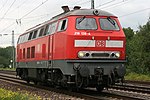
|
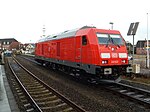
|
| 101 (Electric loco) | 146.5 (Electric loco) | 147.5 (Electric loco) | 218 (Diesel loco) | 245 (Diesel loco) |
Coaching stock
[edit]Early Intercity trains used classic Eurofima stock, shared with TEE and D-Zug expresses, but with the growth of the network in the 1980s, and the inclusion of second class, large numbers of new air-conditioned coaches were built, which are still in use to this day. In the mid-1990s driving trailers were introduced on Intercity and Interregio services, which had the effect of speeding up journey times: many major German railway stations are termini, so a lot of Intercity services include at least one change of direction. With the demise of InterRegio in 2002, a large number of IR coaches were incorporated in Intercity services – particularly second class coaches but also the Bistro Café, which had replaced a full restaurant car on most routes.
Between 2012-2014, Deutsche Bahn undertook a refurbishing program named IC mod to renew its remaining Intercity coaches with updated interiors similar to that found in the ICE 3 fleet.[9]
In December 2023, DB retired all remaining bistro and restaurant cars from IC services due to them being prone to technical issues and reaching the end of their lifespan. While mobile catering was introduced on some routes, several InterCitys lost food and beverage services entirely.[10]
Formations
[edit]Intercity trains are usually 5 to 11 coaches long, depending on the route. There are one or two first class coaches – one compartment coach, and one open on longer trains. Most of the second class coaches are open, but with some compartments, and some ex-Interregio coaches. Cycle space is provided by the driving trailer, but these are not used on all routes, so there are some non-driving coaches with space for bicycles.
Livery
[edit]Intercity coaches were originally in the blue and beige colour scheme employed on D-Zug services, with first class coaches in the TEE dark red and beige. A rebranding of the Deutsche Bundesbahn in the mid-1980s saw a new colour scheme for Intercity services, orient red and light grey with a pastel pink stripe in between. When DB adopted traffic red as its corporate colour in the mid-1990s, this replaced orient red, with the pink stripe taken off, before a new livery was introduced in 2000s – based on the Intercity-Express, the coaches are all white with a red stripe.
Overview
[edit]| Image | Description | Classification | Interior | Refurbished interior |
|---|---|---|---|---|

|
1st class open | Apmz | 
|
|
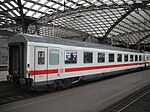
|
1st class compartment | Avmz | 
|

|
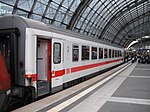
|
2nd class open | Bpmz | 
|
|
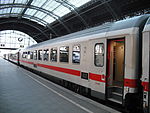
|
2nd class open with wheelchair space | Bpmbz | ||
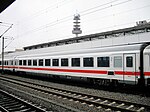
|
2nd class compartment & open, train conductor compartment, baby compartment | Bvmsz | 
|
 
|
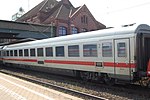
|
2nd class compartment & open | Bvmz | 
|
|

|
2nd class compartment (former 1st class) | Bwmz | 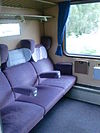
|
|

|
2nd class compartment & open (ex-InterRegio) | Bimz | 
|
|
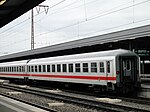
|
2nd class compartment & open with cycle space (ex-InterRegio) | Bimdz |  
|
|
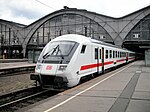
|
2nd class compartment & open driving trailer (ex-Inter Regio) | Bimdzf | ||

|
2nd class driving trailer | Bpmbdzf |
Rolling stock replacement
[edit]
Deutsche Bahn plans to replace most Intercity and Eurocity rolling stock with Intercity-Express ICE 4 electric multiple unit trainsets by 2025.[11] ICE 4 is a Deutsche Bahn project to procure up to 300 fourth generation Intercity-Express trains to replace its existing Intercity fleets used on long-distance passenger services in Germany.[12]
In addition to the ICE 4, Deutsche Bahn has awarded Bombardier Transportation a contract to supply double-decker coaches for Intercity services. These kind of coaches are used in German Regional-Express trains, for Intercity services the coaches will get a more comfortable interior than in regional train double-decker coaches. In both classes only open coaches are provided, there will be no dining car.[13] The double-decker coaches have been in service since 2015.[14] Unlike most previous IC stock the new trains, marketed as "InterCity 2" by DB have a top speed of 160 km/h and are mainly intended for routes where higher speeds aren't possible or would offer little or no benefit with the ICE 4 to take over routes with maximum speeds between 160 km/h and 250 km/h. The IC2 is also intended to expand the Intercity network to cities that had lost their long-distance service upon withdrawal of the Interregio.
See also
[edit]- EuroCity in Germany
- Intercity-Express
- Trans Europe Express
- InterCity (in other countries)
Notes
[edit]- ^ "Vortrag Änderungen im DB Fernverkehr ab Dezember 2017" (PDF) (in German). DB Fernverkehr. 14 September 2017. p. 41. Archived (PDF) from the original on 5 October 2021. Retrieved 5 March 2022.
- ^ "Tarifkooperation Bremen–Norddeich" (in German). LNVG. Retrieved 17 December 2023.
- ^ "Intercity-Züge auf der Strecke Norddeich Mole–Bremen Hbf" (in German). oepnv-info.de. Retrieved 17 December 2023.
- ^ "Die Bahn erhöht zum 9. Dezember ihre Preise". Badische Zeitung (in German). 4 October 2018. Retrieved 6 March 2022.
- ^ "Abschied von der Vogelfluglinie". Frankfurter Allgemeine Zeitung (in German). 15 October 2019. Retrieved 6 March 2022.[permanent dead link]
- ^ "Versnelling naar Berlijn: vanaf vandaag in minder dan zes uur" (in Dutch).
- ^ "Neues Angebotskonzept auf der Gäubahn und Vorstellung von Intercity 2 und Talent 2" (Press release) (in German). Baden-Württemberg Minister for Transportation. 1 December 2017. Archived from the original on 29 January 2022. Retrieved 8 March 2022.
- ^ "Baubedingte Fahrplanänderungen | Deutsche Bahn AG" (in German). Deutsche Bahn AG, Unternehmensbereich Personenverkehr, Marketing eCommerce. Retrieved 10 May 2024.
- ^ see for example File:IC mod Umbauschild der Deutschen Bahn 2013 01 20.jpg
- ^ stern.de "Deutsche Bahn abandons Bistros in IC-trains"] (German) 10 October 2023
- ^ "Siemens preferred bidder for ICx inter-city train deal". Railway Gazette International. 25 January 2010.
- ^ Ralf Roman Rossberg (25 September 2008). "DB keeps ICX options open". Railway Gazette International. Archived from the original on 8 August 2020. Retrieved 6 July 2013.
- ^ "DB orders double-deck trains for long-distance services". Railway Gazette International. 12 January 2011. Archived from the original on 2 June 2019. Retrieved 26 January 2014.
- ^ "Bahn muss bis 2015 auf neue Doppelstock-Intercitys warten". Reuters. 24 November 2013. Archived from the original on 1 February 2014.
External links
[edit]![]() Media related to InterCity (Germany) at Wikimedia Commons
Media related to InterCity (Germany) at Wikimedia Commons
- Deutsche Bahn (in German)
- DB Intercity 1 (IC1) (in German)
- DB Intercity 2 (IC2) (in German)
- Fernbahn.de – Information on long-distance train services in Germany (in German)
- 2023 Deutsche Bahn IC/EC Network
